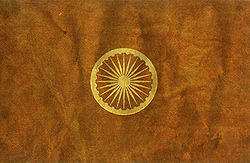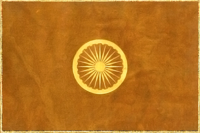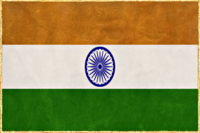Difference between revisions of "Maratha Confederacy (ETW Faction)"
(added artillery) |
m (Playablelity Status) |
||
| (2 intermediate revisions by 2 users not shown) | |||
| Line 1: | Line 1: | ||
| − | {{Faction|image=[[Image:Xx.jpg|250px]]|Name=Maratha Confederacy|Game=[[Empire: Total War]]|Religion=[[Hindu (ETW Religion)|Hindu]]|Culture=Indian}} | + | {{Faction|image=[[Image:Xx.jpg|250px]]|Name=Maratha Confederacy|Game=[[Empire: Total War]]|Religion=[[Hindu (ETW Religion)|Hindu]]|Culture=Indian|Playable= Yes}} |
The Maratha Confederacy is one of the 11 playable major factions in Empire: Total War's Grand Campaign. | The Maratha Confederacy is one of the 11 playable major factions in Empire: Total War's Grand Campaign. | ||
==Overview== | ==Overview== | ||
| − | [[ | + | [[File:MarathaConfederacy_FlagETW.png|200px|Monarchy]] [[File:MarathaConfederacyAlternate_FlagETW.png|200px|Republic]] |
The Maratha Empire or Confederacy was born in violence, as the result of the successful overthrow of Mughal rule less than a generation ago. Raja (king) Shivaji managed to gain control of the Pune region, and from then Mughal power was no longer invincible. As might be expected, the Mughals and the Marathas still nurse a dislike for each other. | The Maratha Empire or Confederacy was born in violence, as the result of the successful overthrow of Mughal rule less than a generation ago. Raja (king) Shivaji managed to gain control of the Pune region, and from then Mughal power was no longer invincible. As might be expected, the Mughals and the Marathas still nurse a dislike for each other. | ||
| Line 151: | Line 151: | ||
===Special Units=== | ===Special Units=== | ||
The Marathas can train an unlimited number of formidable Sikh solders out of the regions of Punjab, Kashmir, and Hindustan. Sikh warriors have superior statistics compared to Hindu units and also have better morale. If the Marathas conquer the Persian regions, they can also train Afghan Hillmen, irregulars. These are the closest the Maratha can come to obtaining light infantry, although their statistics are vastly inferior. | The Marathas can train an unlimited number of formidable Sikh solders out of the regions of Punjab, Kashmir, and Hindustan. Sikh warriors have superior statistics compared to Hindu units and also have better morale. If the Marathas conquer the Persian regions, they can also train Afghan Hillmen, irregulars. These are the closest the Maratha can come to obtaining light infantry, although their statistics are vastly inferior. | ||
| − | |||
{{ETW Factions}} | {{ETW Factions}} | ||
| + | |||
| + | [[Category:ETW Factions]] | ||
Latest revision as of 09:45, 30 July 2020
| Maratha Confederacy (ETW Faction) | |
|---|---|
 | |
| Name: | Maratha Confederacy |
| From Game: | Empire: Total War |
| Religion: | Hindu |
| Culture: | Indian |
| Playable: | Yes |
The Maratha Confederacy is one of the 11 playable major factions in Empire: Total War's Grand Campaign.
Contents
Overview
The Maratha Empire or Confederacy was born in violence, as the result of the successful overthrow of Mughal rule less than a generation ago. Raja (king) Shivaji managed to gain control of the Pune region, and from then Mughal power was no longer invincible. As might be expected, the Mughals and the Marathas still nurse a dislike for each other.
Unlike the foreign (in origin) Mughals, the Maratha rulers are Indian princes and kings. They know the value of the Indian way of doing things, of the age-old strength of their lands. Their armies may look old fashioned, possibly quaint to foreign eyes, but that makes them no less effective. The empire exists solely because it has the military strength to withstand the Mughal threat.
Perhaps now, though, it is time to think of expansion. It may no longer be enough to hold off the Mughals; perhaps they should be driven from India altogether, and a new empire with Indian rulers established. Perhaps only Indians truly have the ability to withstand the Europeans who are starting to demand much of India. For now, the Europeans want only money and trade, but soon they will be after concessions, a little piece of land here, another piece there, until all is ruled by foreigners from across the sea. Unless a strong hand guides India, it is possible that the rule of Mughal outsiders will be replaced by the lordship of European outsiders.
And perhaps, one day, a Maratha could demand concessions from a European, in his lands…
Details
Maratha has severe weaknesses--the inability to utilize Fire by Rank (and other equivalent squad firing technologies) and the complete lack of any formal light infantry. These deficiencies will haunt them in the late-game where both are important assets. The Maratha do, however, possess large amounts of high-quality melee infantry, elephants, and good artillery. Sikh Musketeers have superb statistics, allowing them to overpower most line infantry even though they lack Fire By Rank; Sikh Warriors can defeat nearly any other regiment in melee combat. The Maratha possess a less-than-average navy.
The Maratha have one of the easier campaigns. All their victory territories are located in India, and they have vast, rich lands to conquer from the Mughals, who in turn are militarily almost powerless. The Maratha's only serious threat in the beginning is Mysore, a powerful minor nation which has a strained relationship with the Maratha. Portugese Goa and Dutch Ceylon may prove to be great trading partners in the beginning of the game but, should the Maratha decide to conquer these regions, neither of these countries can do anything about it other than sending ships to raid trade routes.
When controlled by the AI, the Maratha Confederacy will most often annex the Mughal Empire, before invading Persia and even the Ottoman Empire if left unchecked and pose the largest obstacle for other nations wishing to expand into India. They may eventually also annex Mysore.
The Maratha Confederacy is the only Hindu faction in the entire game. This means that it will experience at least some religious unrest in every region it conquers, and will have to build many religious facilities to address this until Secular Humanism is researched.
Starting Position
Victory Conditions
Short Campaign
Capture and hold 15 regions by the end of the year 1750, including Gujarat, Hindustan, Hyderabad, Goa, Malwa, Bijapur, Berar, Carnatica, Mysore, and Ahmadnagar.
Long Campaign
Capture and hold 24 regions by the end of the year 1799, including Gujarat, Hindustan, Hyderabad, Goa, Malwa, Bijapur, Berar, Carnatica, Mysore, Ahmadnagar, Punjab, Orissa & Circars, Bengal, and Ceylon.
World Domination
Capture and hold 40 regions by the end of the year 1799, including the region Bijapur.
Basics at start
- Protectorates – None
- Allies – None
- Trade Partners – United Provinces, Mysore
- Enemies – Pirates, Mughal Empire
- Religion – Hinduism
- Government – Absolute Monarchy
- Ruler – Tarabai I (Queen)
- Population – 2,483,276
- Prosperity – Moderate
- Prestige – Feeble
- Treasury – 7500
- Technology - None
- Brahmin – Abhinash Yalamanchili (Bijapur)
- Eastern Scholar – Shrimant Pannu (Bijapur)
- Thugee – Gagan Raavi (Ahmadnagar)
- Generals - Rustam Akurdikar (Satara), Jainil Rawat (Ahmandnagar), Balkrishna Indukuri (Hyderabad)
- Admirals - None
India Theatre
Satara, Bijapur
- Starting Buildings – Barracks, Subadar’s Palace, Nautch Dancing School, Cannon Foundry, Settlement Fortifications
- Infrastructure - Basic Roads
- Population – 802,138
- Wealth – 3602
- Religion – Hinduism 85.0%, Islam 15.0%
- Starting Towns/Ports – Khed Wetlands (Rice Paddies), Kolhapur (School), Bijapur (Cotton Weaver’s Cottage), Vengurla (Trading Port)
- Later Villages/Ports – None
- Plantations – Yadgir Plantations (Small Cotton Plantation)
Arcot, Caranatica
- Starting Buildings – Military Governor’s Encampment, Settlement Fortifications
- Infrastructure – Basic Roads
- Population – 1,681,138
- Wealth – 4905
- Religion – Hinduism 90.0%, Islam 10.0%
- Starting Towns/Ports – Gudur Wetlands (Rice Paddies), Rajapalaiyam Mines (Open Gem Pit), Trichinopoly (Tavern), Cochin (Cotton Weaver’s Cottage), Calicut (Trading Port)
- Later Villages/Ports – Madras (Port), Pondicherry (Port)
- Plantations – Darahpuram Plantation (Small Tea Plantation), Periyar Plantation (Small Spice Plantation)
Units
The Marathas Confederacy does not boast outstanding armies of line infantry and grenadiers, like those of their European counterparts. Rather, especially in the beginning of the campaign, the faction relies more heavily on melee units, such as Hindu Swordsmen, to close the gap and fight the enemy.
However, being situated in India, generals have access to elephants instead of horses, which not only are sturdy and boast ranged weaponry, but also provide a morale effect against any potential adversaries (the downside being a larger target for enemy cannon).
Artillery
- Large Mortars
- Guns
- Cannons
- 64-lber Great Gun
- Mortars
- Rocket Band
- 12-lber Foot Artillery
- 18-lber Foot Artillery
- 24-lber Foot Artillery
Infantry
- Armed Populace
- Armed Peasantry
- Firelock Armed Populace
- Afghan Hillmen
- Kurdish Hillmen
- Landless Rabble
- Desert Warriors
- Tufangis
- Bargir Infantry
- Musketmen
- Sikh Musketeers
- Hindu Musketeers
- Sikh Warriors
- Hindu Warriors
- Ghoorkas
- Pandours
- Native Warrior Auxiliary
- Native Bowmen Auxiliary
- Native Musketmen Auxiliary
- Dahomey Amazons
Cavalry
- Bargir Lancers
- Sipahis
- Pindari Horsemen
- Camel Nomads
- Silladar Lancers
- War Elephants
- Shaturnal Camel Gunners
- Elephant Musketeers
- Indian General
- Mounted Tribal Auxiliary
- Brig
- Sloop
- Sixth Rate
- Fifth Rate
- Admiral's Flagship, 5th Rate
- Fourth Rate Ship of the Line
- Third Rate Ship of the Line
- Admiral's Flagship, 3rd Rate
- Second Rate Ship of the Line
- First Rate Ship of the Line
- Heavy First Rate
- Admiral's Flagship, 1st Rate
- Carronade Frigate
- Bomb Ketch
- Dhow
Special Units
The Marathas can train an unlimited number of formidable Sikh solders out of the regions of Punjab, Kashmir, and Hindustan. Sikh warriors have superior statistics compared to Hindu units and also have better morale. If the Marathas conquer the Persian regions, they can also train Afghan Hillmen, irregulars. These are the closest the Maratha can come to obtaining light infantry, although their statistics are vastly inferior.

